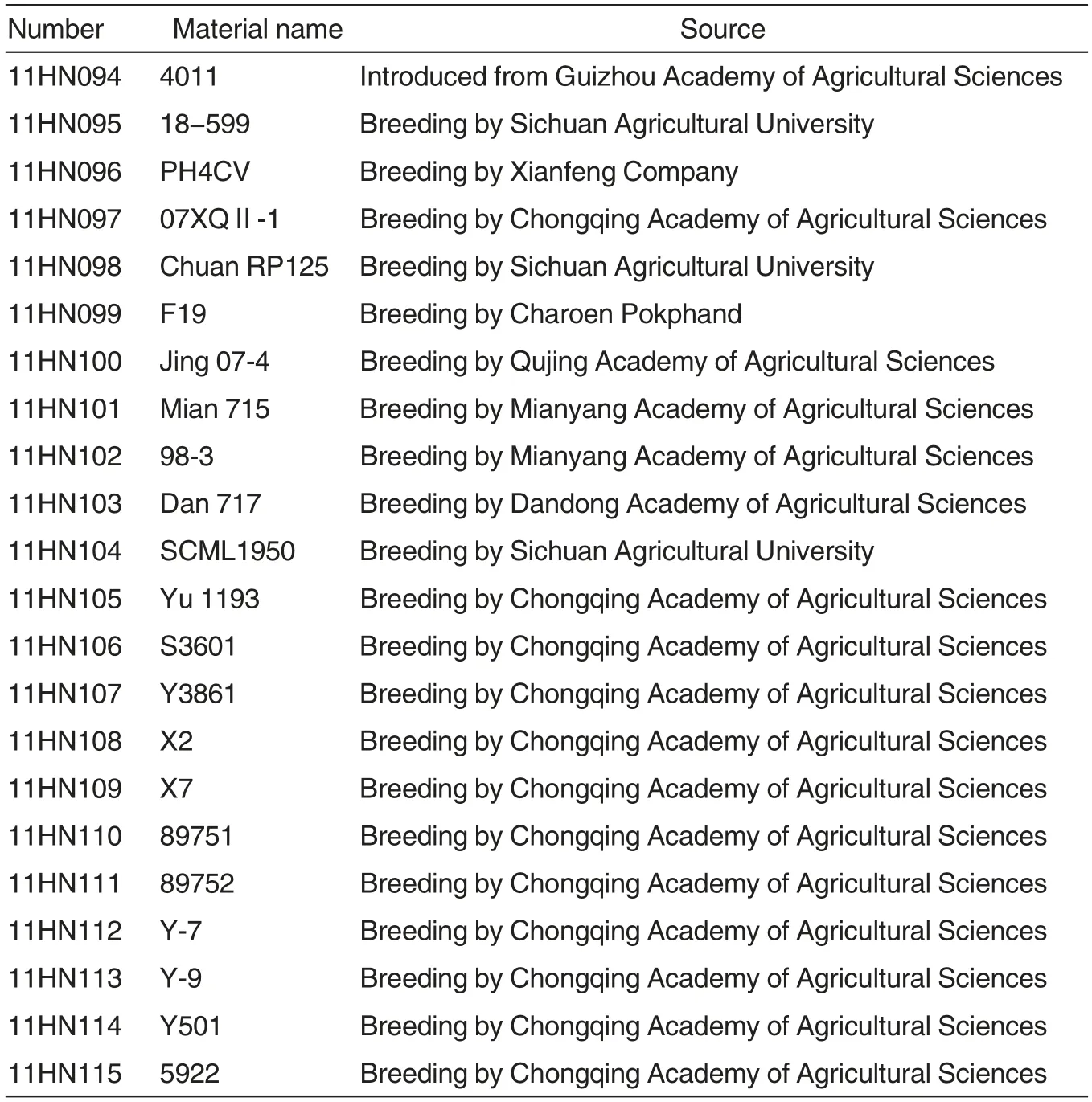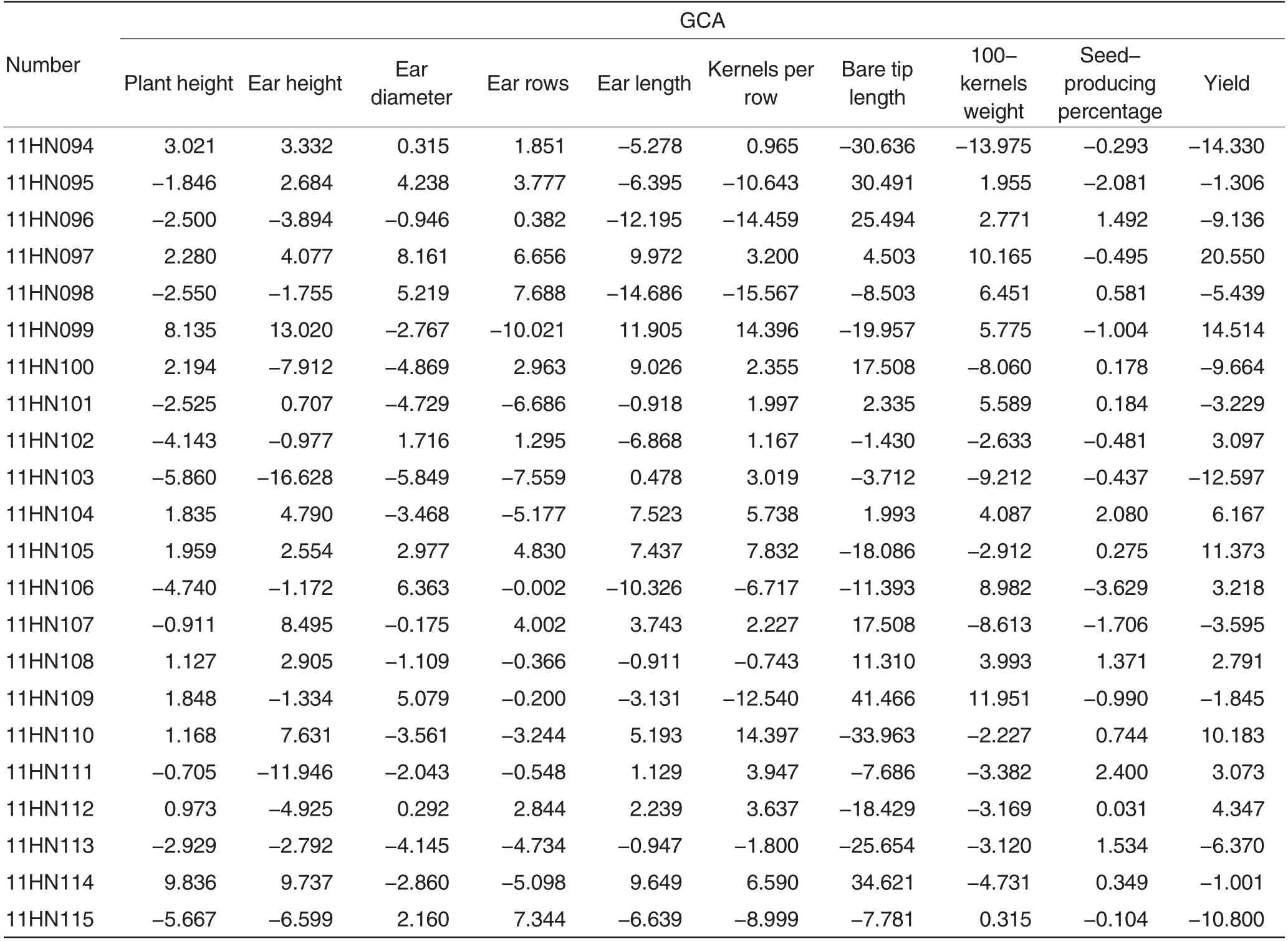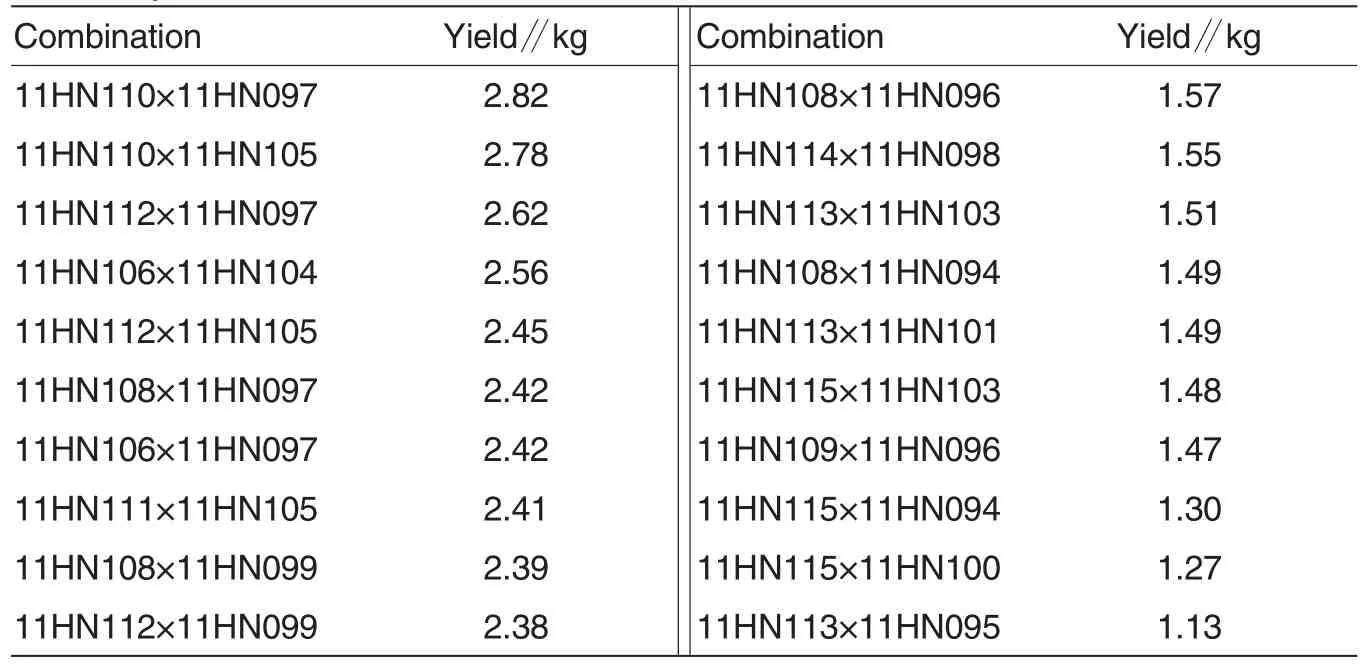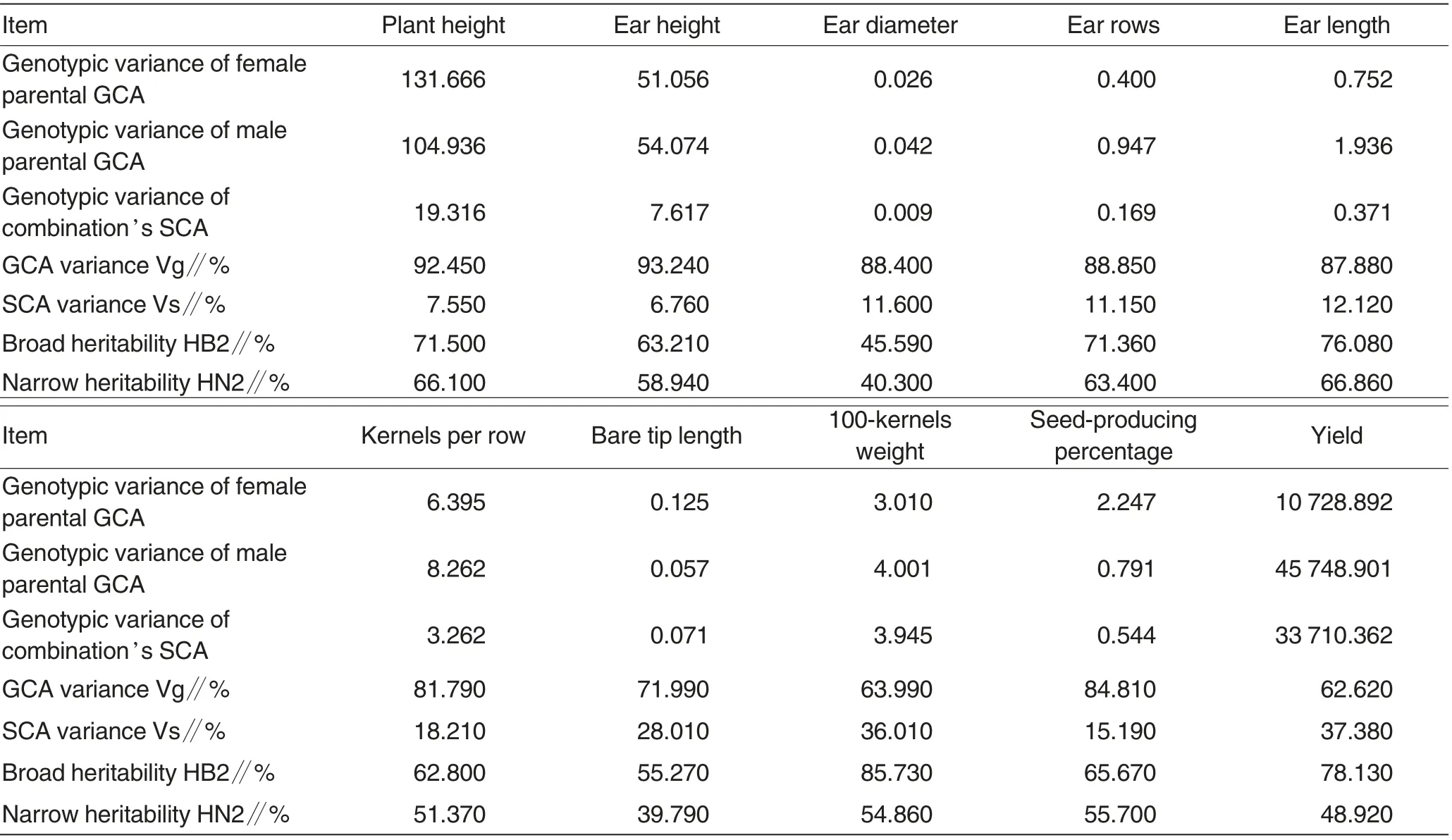Analysis on Combining Ability and Genetic Parameters of Main Agronomic Characters of 22 Maize Inbred Lines
2015-12-14YaqinZHANGZhenggaoQIUHuaYANGZhiyunQILingTANGShujunLIPihuiZHANGLiangYUAN
Yaqin ZHANG, Zhenggao QIU, Hua YANG, Zhiyun QI, Ling TANG, Shujun LI, Pihui ZHANG,Liang YUAN
Maize Research Institute, Chongqing Academy of Agricultural Sciences, Chongqing 401329, China
Heterosis is mainly used in current maize breeding, which also called combining ability breeding[1].Combining ability is a main standard for the measurement of maize inbred lines[2]and an index to comprehensively evaluate the coordinate abilities of various characters of inbred lines[3]. Breeding of parents is the key for maize breeding and heterosis utilization. Based on the law of heterosis and the action principle of gene to correctly evaluate, improve and use germplasm resources is not only helpful to overcome the blindness of hybridization and improve breeding efficiency but also the theoretical and method basis to perform germplasm enhancement and improvement research. Through analyzing on combining ability and genetic parameters of different types of maize inbred lines,the improvement of inbred lines and screening of maize inbred lines with high combining ability has been widely studied[3-7]. The combining ability and genetic parameters of 12 new inbred lines bred by writers and ten introduced lines were analyzed in the research to provide a theoretical basis for the improvement and utilization of inbred lines,and collocation of combinations with strong heterosis.
Materials and Methods
Test materials
Twelve inbred lines bred by Maize Research Institute,Chongqing Academy of Agricultural Sciences and ten introduced lines were used as test materials(Table 1).

Table 1 Test materials and sources
Test methods
11 HN 106, 11 HN 107, 11 HN 108, 11 HN 109, 11 HN 110, 11 HN 111, 11 HN 112, 11 HN 113, 11 HN 114, 11 HN 115 were used as female parents and 11 HN 094, 11 HN 095,11 HN 096,11 HN 097,11 HN 098,11 HN 099, 11 HN0100, 11 HN 0101, 11 HN 0102,11 HN 0103,11 HN0104,11 HN 0105 were used as male parents.According to incomplete diallel cross,10×12 hybridized combinations were collocated in the test base of the Ninth Institute of Hainan,Chongqing Academy of Agricultural Sciences in the winter of 2011. The combinations were planted in the Huangtian base of Maize Research Institute, Chongqing Academy of Agricultural Sciences in 2012. Randomized block design was used for the test and the test was performed three times. Single row plot was adopted in the test and the row length was 3.1 cm; the line spacing was 0.95 m; fourteen plants were planted in each line. Whole plants were harvested to calculate yield. The previous crop was maize and the cultivation and management were similar with field planting.
Character investigation
Plant height (cm) and ear height(cm) of five plants were continuously investigated during maturation stage.Ear diameter (cm), ear length (cm),bare tip length (cm), ear rows (number) and kernels per row (number) of five fruit spikes were randomly investigated after harvest and the average values were adopted. Plot yield (kg),100-grain weight (g) and seed-producing percentage (%) were calculated after wheat was threshed and dried.
Statistical Analysis Method
Incomplete diallel cross method introduced by Liu et al[8]. And Gao[2]were adopted to analyze the combining ability and estimate the genetic parameters of the ten agronomic characters of 22 maize inbred lines. DPS 3.01 software was used for data statistics.

Table 2 Variance analysis of each character
Results and Analysis
Variance analysis of various characters
The results showed that according to the variance analysis of combining abilities and randomized blocks of the ten characters (Table 2), the differences among combinations reached extremely significant levels,which illustrated that there were true differences among the ten characters and the genotypic differences of the characters were caused by genetic factors, and the variances were heritable. The GCA variances of the ten characters of the two combinations reached extremely significant levels,which indicated that the GCA of the measured characters had extremely significant differences among parents and the GCA could be further analyzed. The SCA variances of the ten characters of the two hybridized combinations reached extremely significant levels or significant levels exceptthe SCA variance of ear diameter.

Table 3 GCA effect values of various characters of materials

Table 4 Ten combinations with the highest yields and ten combinations with the lowest yields
Analysis of GCA relative effect
GCA is the average performance of the effect of a parental character on hybridized combinations. It is heritable and mainly controlled by additive gene effect. A high GCA resulted in a high heritability and environment has a small effect on the character[4,9-13].
Table 3 showed that there were big differences among the GCA relative effects of a same character in different inbred lines. Among the 22 inbred lines, the GCA relative effects of plant height and ear height of eight inbred lines had big negative values.The eight inbred lines were 11 HN 096, 11 HN 098, 09 HN 102, 11 HN 103, 11 HN 106, 11 HN 111, 11 HN 113 and 11 HN 115.The GCA relative effects of ear diameter and ear rows of 11 HN 095,11 HN 097,11 HN 098,11 HN 102, 11 HN 105, 11 HN 112 and 11 HN 115 were positive values,which is useful for the increasing of ear diameter and ear rows of hybridized combinations. The GCA relative effects of ear length and kernels per ear of 11 HN 099,11 HN 103,11 HN 105,11 HN 110, 11 HN 111, 11 HN 112 and 11 HN 113 were big while the GCA relative effects of bare tip length were big negative values. These parents can be used to increase the ear length and kernels per ear of hybridized combinations. The GCA relative effects of 100-grain weight of 11 HN 097 and 11 HN 109 were big and hybridized combinations of large grain type can be easily obtained by the two parents. The relative effects of yield GCA of the ten inbred lines were positive values and the top four parents were 11 HN 097, 11 HN 099, 11 HN 105 and 11 HN 110, which were elite inbred lines to combine hybridized combinations with strong advantages.High yielding hybridized combinations can be easily collocated with them as parents. Other inbred lines can be used selectively according to thebreeding objectives in actual work.
Table 4 showed the top ten combinations of the highest plot yield and ten combinations of the lowest plot yield.It could be seen from the parents of the ten combinations with the highest plot yield that the relative effects of yield GCA of the parents were high.Among the parents of the five hybridized combinations with the lowest yields, only 11 HN 108 had a positive yield GCA and the yield GCAs of other parents were negative values. The results indicated that parents with high GCA should be selected to collocate hybridized combinations with high yield.

Table 5 Effect values of yield SCA(Sij)

Table 6 Estimation of the genetic parameters of various characters
Relative effect of yield SCA of hybridized combinations
SCA is the deviation of GCA expected result of hybridized combination and parents[2].The value of SCA is decided by the non-addictive gene effect of parent genotype, which is the comprehensive result of interaction effect of gene dominance and epistasis,gene and environment. It can not be inherit stably between generations but it can direct heterosis utilization and hybrid breeding[14-15]. Table 5 showed that the relative effects of yield SCAs of 63 combinations were positive values and the top five combinations were 11 HN 106 × 11 HN 103, 11 HN 106×11 HN 104,11 HN 110 ×11 HN 105, 11 HN 106 × 11 HN 096 and 11 HN 113 × 11 HN 102. Among the 120 combinations, the yields of 11 HN 110×11 HN 097,11 HN 110×11 HN 105,11 HN 112 × 11 HN 097 and 11 HN 106 × 11 HN 104 were respectively 18.9%, 17.3%, 10.2% and 7.8% more than the control Yudan 8.The yields of the four combinations were the highest. The yielding ability, adaptability and yielding stability of the four combinations can be further identified by tests.
Analysis on genetic parameters of the main agronomic characters
Table 6 showed that the GCA genotypic variances of the ten characters were bigger than the SCA genotypic variances, which illustrated that the characters were mainly controlled by additive gene effect and slightly affected by non-addictive gene effect. Therefore, parent originated from parents with good performances should be selected to fully exert addi-tive gene effect, namely that GCA of the characters was more important.According to the differences of male parents and female parents, for the GCA of plant height, bare tip length and seed-producing percentage, the female parent was more important and the character selection should be mainly focused on female parents.For the GCA of other characters, male parent was more important.
The rank of broad heritability of each character from bigger to smaller was: plant height, ear height, seedproducing percentage, 100-grain weight, ear length, yield, kernels per row, bare tip length, ear rows and ear diameter.Meanwhile,the narrow heritabilities of plant height, ear position,ear rows, ear length, kernels per row,100-grain weight and seed-producing percentage were more than 50% ,which illustrated that these characters were not easily influenced by environment and the variances were mainly resulted from heredity, and these characters were easily to be selected in early-generation.However,the narrow heritabilities of ear diameter, bare tip length and yield were low, which illustrated that these characters were mainly controlled by non-additive gene effect, easily influenced by environment and selection was not suitable in early-generation.
Discussions and Conclusions
Appropriate GCA effect values of plant height and ear height are useful to improve yield.The GCA effect value of bare tip length was a negative heterosis and a smaller GCA effect value was more helpful to increase yield.The effect values of other ear characters and yield were positive heteroses and a bigger GCA effect value was more useful to improve ear characters and yield, and combine high-yielding hybridized combinations[3]. The GCA variances of the ten characters of the two set of parents had significant differences or extremely significant differences. The yield GCA effects of 11 HN 097, 11 HN 099, 11 HN 105 and 11 HN 110 were high, which were good inbred lines to collocate hybridized combinations with strong heterosis. The GCAs of the parents of high yielding combinations were higher.In breeding work,collocation of hybridized combination was not only based on the field performance of inbred lines but also based on the GCA of inbred lines. Thus, breeding efficiency could be improved and hybridized combination with strong heterosis could be collocated.
Only the SCA variance of ear diameter did not reach a significant level while the SCA variances of other characters reached significant levels. The yield SCAs of the tested combinations were significantly different. The yields of 11 HN 110×11 HN 097,11 HN 110×11 HN 105, 11 HN 112 × 11 HN 097 and 11 HN 106 × 11 HN 104 were the top four, and the yielding ability,adaptability and yielding stability could be further identified by experiment.
In the research, the GCA variances of the ten characters of the two set of parents were bigger than SCA genetic variances and more than 50%,which illustrated that these characters were mainly controlled by additive gene effect and slightly affected by non-additive gene effect. Therefore,parent originated from parents with good performances should be selected to fully exert additive gene effect,namely that the GCAs of the characters were more important. The narrow heritabilities of plant height,ear height,ear rows, ear length, kernels per row,100-grain weight and seed-producing percentage were more than 50% ,which illustrated that these characters were not easily influenced by environment and the variances were mainly controlled by heredity, and these characters were easily to be selected in early-generation.However,the narrow heritabilities of ear diameter, bare tip length and yield were low, which illustrated that these characters were mainly controlled by non-additive gene effect, easily influenced by environment and it was not suitable to perform selection in early-generation.
Elite inbred lines were relative.The yield GCA effects of 11 HN 097,11 HN 099,11 HN 105 and 11 HN 110 were high, which were good inbred lines to collocate hybridized combinations. However, some characters of the four inbred lines were not good.The GCA effects of plant height and ear height of the four inbred lines were positive values. The GCA effects of bare tip length and seed -producing percentage of 11 HN 097 were negative values.The GCA effects of ear diameter, ear rows and seed-producing percentage of 11 HN 099 were negative values. The GCA effect of 100-grain weight of 11 HN 105 was negative value. The GCA effects of ear diameter, ear rows and 100-grain weight of 11 HN 110 were negative values. Therefore, purposeful improvement should be performed in breeding based on the disadvantages.Parents should be chosen based on the GCAs among characters and the GCA effects of male and female parents. Thus breeding efficiency could be improved.
[1]SHI ML (石明亮).Combining ability and genetic basis of yield relative characters of new maize inbred line and the QTL of GY 220/1145(玉米新选自交系产量相关性状配合力和遗传基础分析及GY 220/1145 组合QTL 定位)[D].Doctoral Dissertation(博士学位论文), Nanjing(中国南京):Nanjing Agricultural University(南京农业大学),2009:15.
[2]GAO ZR(高之仁).Quantitative Genetics(数量遗传学)[M]. Chengdu (成都):Sichuan University Press(四川大学出版社),1986:314-433.
[3]WANG TG(王铁固),ZHAO XL(赵新亮),ZHANG HS (张怀胜), et al. Combining ability analysis and genetic parameter estimation of maize yield and relative characters(玉米产量及相关性状的配合力分析和遗传参数估算)[J].Guangdong Agricultural Sciences (广东农业科学),2012(10):15-17,34.
[4]QI ZY(祁志云),YANG H(杨华),QIU ZG(邱正高), et al. Correlations between the combining ability of maize DH line ear characters and the general combining ability (玉米DH 系穗部性状配合力及其一般配合力相关性分析) [J].Southwest China Journal of Agricultural Sciences (西南农业学报),2011,24(5):1642-1650.
[5]QIU ZG(邱正高),QI ZY(祁志云),LEI KR(雷开荣), et al. Clustering analysis and combining ability of quantitative traits of different types of maize inbred lines (不同类型玉米自交系数量性状配合力及聚类分析)[J].Southwest China Journal of Agricultural Sciences (西南农业学报),2012,25(2):379-384.
[6]WANG BW(王兵伟), HUANG AX(黄安霞),QIN YY (覃永媛),et al.Analysis on combining ability of several main char-acters using 20 waxy maize inbred lines(20 个糯玉米自交系几个主要性状的配合力分析)[J].Southwest China Journal of Agricultural Sciences (西南农业学报),2012,25(1):22-27.
[7]YANG X(杨雪),HU XA(胡学爱),YANG R(杨荣),et al.Analysis on combining ability of main characters of several maize inbred lines(几个玉米自交系主要性状的配合力分析)[J].Southwest China Journal of Agricultural Sciences(西南农业学报),2009,22(3):572-574.
[8]LIU LF (刘来福), MAO SX (毛盛贤),HUANG YZ (黄远樟).Crop quantitative inheritance (作物数量遗传)[M]. Beijing(北京):Chinese Agricultural Press(中国农业出版社),1984:206-249.
[9]WU JC(吴健聪),XU CX(徐春霞),CHEN HM (陈洪梅),et al.Studies on combining ability and heterotic grouping of 24 quality protein maize inbreds and four temperate representative inbreds of chinese major heterotic groups(24 个优质蛋白玉米自交系与中国温带玉米四大优势群代表自交系的配合力和杂种优势群研究)[J].Agricultural Sciences in China(中国农业科学),2007,40 (6):1288-1296.
[10]WANG XD(王向东),GAO GL(高根来),ZHANG FQ (张风琴), et al. Genetic analysis of combining ability of yield properties of maize(玉米产量性状配合力遗传分析)[J]. Journal of maize Science(玉米科学),2001,9(1):31-33.
[11]QI ZY (祁志云),YANG H (杨华),QIU ZG (邱正高),et al.Clustering analysis and combining ability analysis of several maize inbred lines (几个玉米自交系的配合力及聚类分析)[J].Journal of Southwest University: Natural Science Edition (西南大学学报: 自然科学版),2010,32(2):19-25.
[12]WU GC(吴广成),XUE Y(薛雁),HE DY(何代元),et al.Combining ability analysis of maize inbred lines (玉米自交系的配合力分析)[J].Maize Science(玉米科学),2003,11(2):32-36,53.
[13]QIU ZG (邱正高), YANG H (杨华),WANG GX (王贵学), et al. Study on mutation effect of space radiation to agronomic traits of waxy maize (航天诱变对糯玉米主要数量性状及配合力的影响)[J]. Southwest China Journal of Agricultural Sciences(西南农业学报),2009,22(5):1249-1252.
[14]YANG YF (杨引福), GUO Q (郭强),QIAN JH (钱劲华). Heredity analysis on combining ability of eight corn inbred lines(8 个玉米自交系主要穗部性状配合力的遗传分析) [J]. Journal of Maize Science (玉米科学), 2008, 16(3):30-33.
[15]SUN HY (孙海燕), CAI YL (蔡一林),WANG GQ(王国强),et al.Analysis on combining ability of ear characters in ten maize inbred lines (10 个玉米自交系穗部性状的配合力分析)[J].Journal of Maize Science(玉米科学),2006,14(4):61-63.
猜你喜欢
杂志排行
Agricultural Science & Technology的其它文章
- Effect of Tree Species and Dosage of Rhizomorph Wood on Asexual Propagation of Wild Gastrodia elata.Bl.f.glauca S.Chow in Ganzi
- Effects of Different Application Times of Tillering Fertilizer on Grain Yield and Population Development of Double-cropping Rice Transplanted by Machine
- Biological Characteristics and Pathogenicities of Shewanella algae and Shewanella abalone from Babylonia
- Research on Physiological Characteristics of Tall Fescue under Nitrogen Stress
- Cloning and Characterization of Phytochrome A Gene FaPHYA from Tall Fescue
- Changes in Physiological Indexes of SPDS Transgenic Potato Plants under Low Temperature Stress
